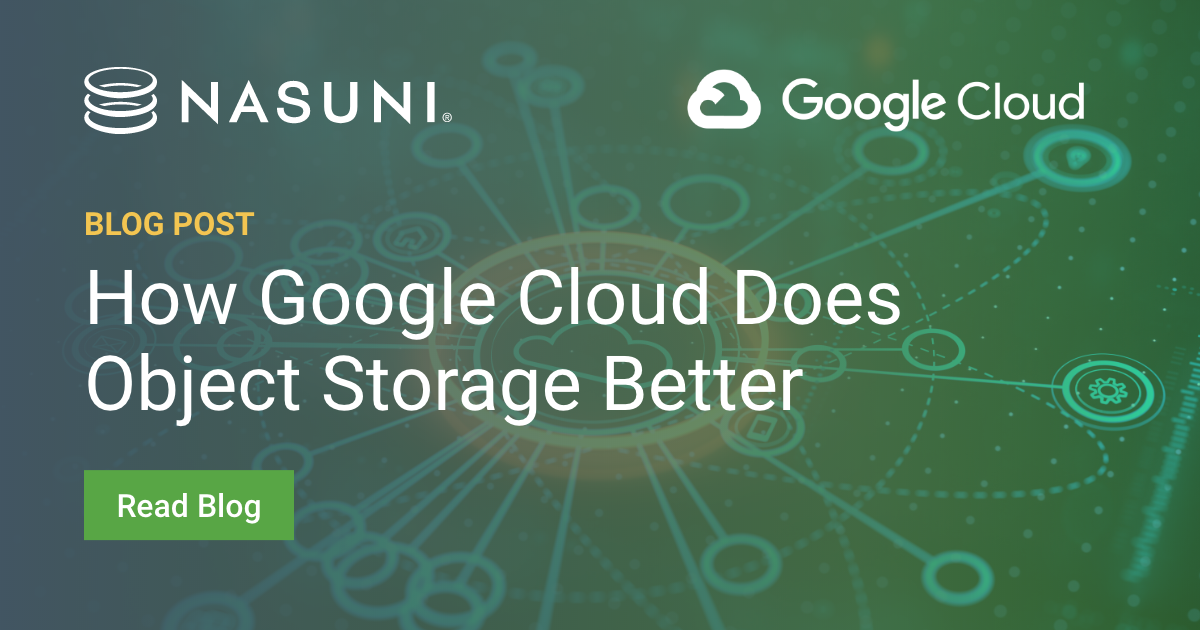How Google Cloud Does Object Storage Better
November 18, 2021 | Bobby Silva
Here at Nasuni our Google Cloud business has been growing steadily since we announced the launch of our partnership earlier this year. We’re seeing more prospects gravitate toward Google Cloud, and more existing customers switch their backend storage from other object storage providers to Google.
One of the drivers behind this momentum is cost — deploying Nasuni in tandem with Google Cloud Storage Archive is 1/5th to 1/3rd the cost of leveraging one of the other hyperscalers. Yet cost isn’t the only metric. Nasuni deals in files, which can be some of an organization’s most important assets, so availability, performance, and durability are absolutely critical.
In this post, I’d like to discuss three of the areas in which Google Cloud really excels from a cloud file storage perspective.
1. High-Performance Infrastructure
Maybe this is obvious, but Google Cloud is unique in part because it’s built on the same infrastructure that powers YouTube, Gmail, and search. The same infrastructure that rapidly serves six billion hours of YouTube videos each month or returns billions of search results in milliseconds. And it has tremendous reach. Globally, Google Cloud’s footprint spans 85 zones and more than 146 points of presence. Google even has its own network of subsea cables to ensure high bandwidth connectivity. For Nasuni users, this incredible global reach and connectivity translate into fast access to all files, even those that aren’t cached locally.
2. Built-in Zonal Redundance
Google Cloud is divided into regions, each of which has multiple zones. When your Nasuni file data is stored in one Google Cloud region, it will also be stored in a minimum of three zones within that region. Each of these zones is in a separate physical space with its own power, networking, and cooling, which gives you eleven 9’s of durability. With the other hyperscalers, customers have to pay extra for this zonal redundancy. With Google’s Cloud Storage, it’s built into the system and included in the already-low price.
3. Dual-Region Superiority
Typically, hyperscalers maintain an active region and a secondary passive one. Nasuni reads and writes to the active bucket and the cloud asynchronously replicates that to the passive region, then charges added egress fees to do so. If there’s an outage at the active location, the hyperscaler has to declare this outage before switching over to the passive region and making it active. The actual switch can be fast, but it might be hours before the cloud admits to the outage and initiates that transition.
Google Cloud, on the other hand, maintains an active/active pair (a single bucket), and there are no added egress or networking costs to replicate data to the second region. Plus, in the event of a regional outage, there’s no need to wait for Google to declare the event and initiate a failover process. It all happens automatically. Read and write requests are directed to the closest region in which the data is available. This is an advantage in terms of durability and recoverability, but it also offers everyday gains. Since reads and writes automatically access the closest region, when a user accesses files through a Nasuni Edge Appliance, that appliance will go to the closest region, minimizing hops and lowering latency.
Google Cloud Storage Roadmap
Looking ahead, we’re excited to see how Google Cloud continues to advance its object storage offerings. One such roadmap feature, Custom Dual-Regions, will allow you to select any two Google Cloud regions on the same continent. In North America, for example, there are currently 9 different regions with three zones each. With Custom Dual-Regions, a company with most of its operations centered in California could select the Los Angeles and Las Vegas regions. An enterprise on the East Coast, on the other hand, could select Virginia and South Carolina or Toronto. This dovetails perfectly with Nasuni cloud file storage and our global file system — the closer the files or cloud-based edge appliance VMs are to the user, the better.
There are several more items on the roadmap that we’re looking forward to here at Nasuni, but Google Cloud’s object storage technology is already making an enormous impact on our business and, more importantly, the success of our customers in embracing cloud file storage.
Bobby Silva shares Nasuni’s efforts to aid evolving global data sovereignty requirements and compliance regulations in addition to being recognized as a Google Cloud Assured Workloads partner.
Lance Shaw shares insight on how switching to hybrid cloud solutions can be positive for both the enterprise and the planet.
Andres Rodriguez shares why enterprises need to get fit for AI and the top factors prohibiting their AI success.


